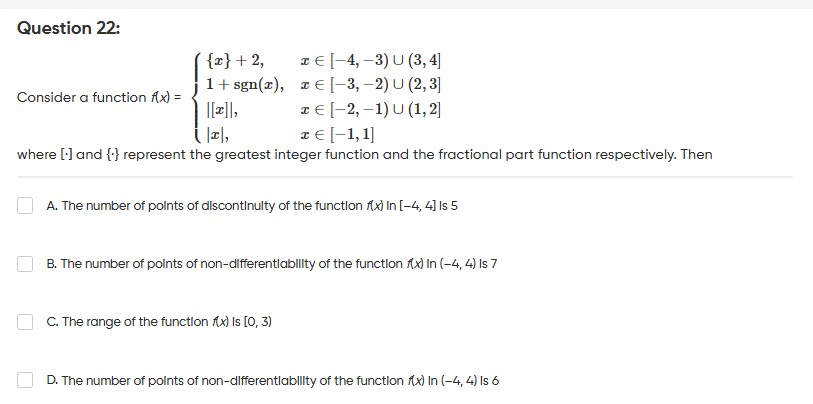Question
Question: Consider a function $f(x) = \begin{cases} \{x\} + 2, & x \in [-4, -3) \cup (3, 4] \\ 1 + \text{sgn}(...
Consider a function f(x)=⎩⎨⎧{x}+2,1+sgn(x),[[x]],∣x∣,x∈[−4,−3)∪(3,4]x∈[−3,−2)∪(2,3]x∈[−2,−1)∪(1,2]x∈[−1,1] where [.] and {.} represent the greatest integer function and the fractional part function respectively. Then

The number of points of discontinuity of the function f(x) in [−4,4] is 5
The number of points of non-differentiability of the function f(x) in (−4,4) is 7
The range of the function f(x) is [0,3)
The number of points of non-differentiability of the function f(x) in (−4,4) is 6
A, B
Solution
The function is defined piece-wise. We analyze continuity and differentiability at the boundaries of these pieces and at points where the definition of the component functions changes.
Continuity Analysis: The function is discontinuous at x=−3,−2,2,4.
- At x=−3: limx→−3−f(x)=3, limx→−3+f(x)=0. Discontinuous.
- At x=−2: limx→−2−f(x)=0, limx→−2+f(x)=−2. Discontinuous.
- At x=−1: limx→−1−f(x)=−2, limx→−1+f(x)=1. Discontinuous.
- At x=1: limx→1−f(x)=1, limx→1+f(x)=1. Continuous.
- At x=2: limx→2−f(x)=1, limx→2+f(x)=2. Discontinuous.
- At x=3: limx→3−f(x)=2, limx→3+f(x)=2. Continuous.
- At x=4: f(4)=2, limx→4−f(x)=3. Discontinuous. There are 5 points of discontinuity in [−4,4]: −3,−2,−1,2,4. Option A is correct.
Differentiability Analysis: Points of discontinuity are also points of non-differentiability: −3,−2,−1,2. We check for non-differentiability at points of continuity where the derivative might change:
- x=0: f(x)=∣x∣. Left derivative is −1, right derivative is 1. Non-differentiable.
- x=1: f(x)=∣x∣ for x≤1 and f(x)=1 for x>1. Left derivative is 1, right derivative is 0. Non-differentiable.
- x=3: f(x)=2 for x<3 and f(x)=x−1 for x>3. Left derivative is 0, right derivative is 1. Non-differentiable. Total points of non-differentiability in (−4,4) are −3,−2,−1,0,1,2,3, which are 7 points. Option B is correct.
Range Analysis:
- For x∈[−4,−3), f(x)=x+6, range is [2,3).
- For x∈(3,4], f(x)=x−1, range is (2,3].
- For x∈[−3,−2), f(x)=0, range is {0}.
- For x∈(2,3], f(x)=2, range is {2}.
- For x∈[−2,−1), f(x)=−2, range is {−2}.
- For x∈(1,2], f(x)=1, range is {1}.
- For x∈[−1,1], f(x)=∣x∣, range is [0,1]. The union of these ranges is [−2,1]∪[2,3]. Option C is incorrect.
